Australian English is the set of varieties of the English language native to Australia. It is the country's common language and de-facto national language; while Australia has no official language, English is the first language of the majority of the population, being the only language spoken in the home for about 72.7% of Australians. It is also the main language used in compulsory education, as well as federal, state and territorial legislatures and courts.
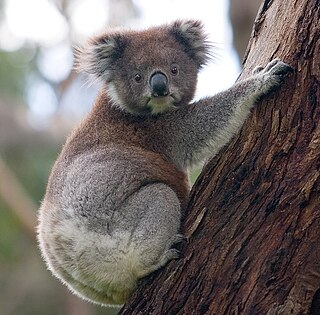
The koala or, inaccurately, koala bear is an arboreal herbivorous marsupial native to Australia. It is the only extant representative of the family Phascolarctidae and its closest living relatives are the wombats. The koala is found in coastal areas of the mainland's eastern and southern regions, inhabiting Queensland, New South Wales, Victoria, and South Australia. It is easily recognisable by its stout, tailless body and large head with round, fluffy ears and large, spoon-shaped nose. The koala has a body length of 60–85 cm (24–33 in) and weighs 4–15 kg (9–33 lb). Fur colour ranges from silver grey to chocolate brown. Koalas from the northern populations are typically smaller and lighter in colour than their counterparts further south. These populations possibly are separate subspecies, but this is disputed.

Telstra Corporation Limited is an Australian telecommunications company which builds and operates telecommunications networks and markets voice, mobile, internet access, pay television and other products and services. It is a member of the S&P/ASX 20 and Australia's largest telecommunications company by market share. Telstra is the largest wireless carrier in Australia, with 18.8 million subscribers as of 2020.

A savanna or savannah is a mixed woodland-grassland ecosystem characterised by the trees being sufficiently widely spaced so that the canopy does not close. The open canopy allows sufficient light to reach the ground to support an unbroken herbaceous layer consisting primarily of grasses.

The saltwater crocodile is a crocodilian native to saltwater habitats and brackish wetlands from India's east coast across Southeast Asia and the Sundaic region to northern Australia and Micronesia. It has been listed as Least Concern on the IUCN Red List since 1996. It was hunted for its skin throughout its range up to the 1970s, and is threatened by illegal killing and habitat loss. It is regarded as dangerous to humans.
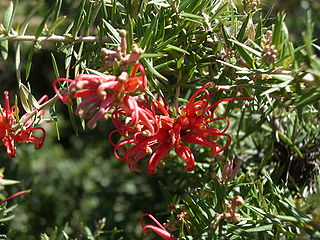
Grevillea juniperina, commonly known as juniper- or juniper-leaf grevillea or prickly spider-flower, is a plant of the family Proteaceae native to eastern New South Wales and southeastern Queensland in Australia. Scottish botanist Robert Brown described the species in 1810, and seven subspecies are recognised. One subspecies, G. j. juniperina, is restricted to Western Sydney and environs and is threatened by loss of habitat and housing development.

Grevillea rhyolitica, also known as Deua grevillea, is a shrub which is endemic to south-eastern New South Wales in Australia. It grows to between 0.5 and 2 metres in height.

Postcodes in Australia are used to more efficiently sort and route mail within the Australian postal system. Postcodes in Australia have four digits and are placed at the end of the Australian address, before the country. Postcodes were introduced in Australia in 1967 by the Postmaster-General's Department and are now managed by Australia Post, Australia's national postal service. Postcodes are published in booklets available from post offices or online from the Australia Post website.

Acidonia microcarpa is a species of shrub in the plant family Proteaceae. It is the only species in the genus Acidonia. It is endemic to the south coast of the Southwest Botanic Province of Western Australia.

Ironopolia sobriella is a moth of the family Oecophoridae. It is found in Australia, where it has been recorded from Queensland, New South Wales, the Australian Capital Territory, Victoria, South Australia and Western Australia. The species was described by Francis Walker in 1863.
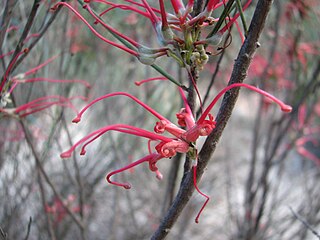
Grevillea sarissa, the wheel grevillea, is a shrub which is native to South Australia and Western Australia.
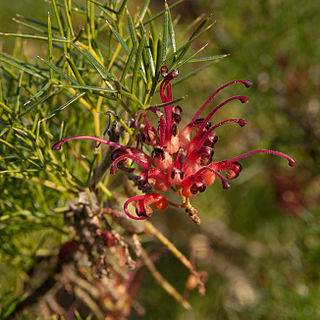
Grevillea maxwellii is a shrub which is endemic to the south west region of Western Australia. It grows to between 0.2 and 1.2 metres in height. The flowers, which have a pink-orange or pink-red perianth and pink-red style, appear in May and from September to November in the species' native range. The species was first formally described by Donald McGillivray in 1986, his description published in New Names in Grevillea (Proteaceae). It is classified as "Declared Rare Flora" under the Wildlife Conservation Act in Western Australia.
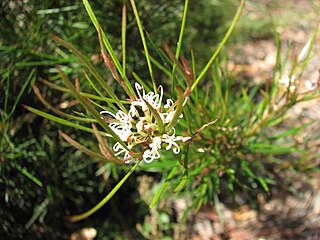
Grevillea neurophylla, commonly known as granite grevillea, is a shrub species in the family Proteaceae. It is native to the states of New South Wales and Victoria in Australia. The species was first formally described by French botanist Michel Gandoger in Bulletin de la Société Botanique de France in 1919. There are two subspecies:
Grevillea parviflora is a shrub species in the family Proteaceae. It is native to the state of New South Wales in Australia. There are two subspecies:

Grevillea sessilis is a shrub which is endemic to Queensland in Australia.

Grevillea newbeyi is a shrub which is endemic to the south west region of Western Australia. It grows to between 0.5 and 1.5 metres in height. The pink to red and cream flowers usually appear from June to December in the species' native range. The species was first formally described by Donald McGillivray in 1986, his description published in New Names in Grevillea (Proteaceae).
Ironopolia ebenosticta is a moth in the family Oecophoridae. It was described by Turner in 1946. It is found in Australia, where it has been recorded from Queensland.
Ironopolia neochlora is a moth in the family Oecophoridae. It was described by Edward Meyrick in 1883. It is found in Australia, where it has been recorded from Queensland.

Ironopolia is a genus of moths of the family Oecophoridae.
The Australasian Virtual Herbarium (AVH) is an online resource that allows access to plant specimen data held by various Australian and New Zealand herbaria. It is part of the Atlas of Living Australia (ALA), and was formed by the amalgamation of Australia's Virtual Herbarium and NZ Virtual Herbarium. As of 12 August 2014, more than five million specimens of the 8 million and upwards specimens available from participating institutions have been databased.













